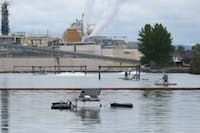Throughout its 160-year existence, the city of St. Helens, Ore., has worked closely with its industrial residents for the benefit of the community. A recent project that teamed the city wastewater treatment plant with the local paper mill cut energy costs and earned a rebate from the electric utility and an award from the state for industrial energy efficiency.
The goal of the project was to reduce the cost of aeration in the 42-acre lagoon, which the town shares with local industry, including a paper mill. To meet their goal of cost-effective operation, officials installed SolarBee mixers from Medora Corp., and as a result cut aeration runtime costs more than 50%. In addition to cutting runtime costs, the project also qualified for a rebate from their serving electric utility, Columbia River PUD, with support from the Bonneville Power Administration’s Energy Smart Industrial (ESI) program.
Focusing on the Secondary Lagoon
The wastewater treatment plant consists of two ponds: a 3-acre primary lagoon that receives loading from the city and smaller industries, and a 40-acre secondary lagoon that receives effluent from the city's primary pond and from the mill’s primary clarifier.
The secondary lagoon is divided into three zones by baffles. Prior to the energy reduction project, 24 mechanical surface aerators in the first two zones ranged from 50 to 150 hp and operated approximately 2,100 hp per day, effectively making them partial-mix zones. The aerators were alternated to maintain thorough mixing: five to six aerators ran constantly in Zone 1 and one aerator ran in Zone 2. A SCADA control system rotated the aerators automatically depending on the level of dissolved oxygen. Zone 3 is a quiescent area, where the solids are allowed to settle. The secondary effluent is discharged into the Columbia River, past Sauvie Island 650 ft into the channel.
Solar-Powered Circulation Payback
Due to downsizing, the mill reduced its loading on the wastewater treatment plant, and the focus changed from maintaining the aerators to reducing the electricity required to run them. The mill had been able to decrease aeration down to the point where mixing was the limiting factor, but the secondary treatment lagoon was still expensive to operate.
Cascade Energy Eng., a BPA ESI program implementation partner, conducted a study at the request of Columbia River PUD to consider energy-saving solutions at the plant. It studied seven months of operational data from the plant’s SCADA system, as well as input from plant personnel.
Engineers considered three options in their study report:
- 1. Replace a portion of the existing surface aerator propeller blades to a lower pitch. This would reduce aeration power but also reduce mixing.
- 2. Replace a portion of the existing surface aerators with aspirating aerators. This would provide adequate aeration, but would create only localized mixing due to the small impellers used.
- 3. Replace a portion of the existing surface aerators with solar-powered mixers. This would reduce the runtime of existing aerators or the number of aerators while also improving mixing.
According to the study, the lower-pitched propeller blades would save 119,553 kW per year; the aspirating aerators would save 91,747 kW per year; and the solar-powered mixers would save 1,375,518 kW per year.
Solar-Powered Mixers Cut Aeration Horsepower
“To me, the choice was obvious,” said Aaron Kunders, superintendent of the St. Helens wastewater treatment plant. “Due to the energy savings and the resources available through the ESI program, Columbia River PUD was able to provide a 70% rebate for the cost of the mixers. It brought the price so far down that our payback was two years. In two years we have a payoff and in four years we make that money back. This one cost a lot more up front, but it also has the biggest return.”
The solution was to install seven SolarBee SB10000 v18 machines: five Zone 1 and two in Zone 2. Each SolarBee mixer can displace between 30 and 60 hp of aeration.
Kunders says that the biggest payoff of the project is for taxpayers. “The cost for all these SolarBee mixers was offset so the cost doesn’t have to go to our taxpayers. Instead of paying 100% of it, the city probably paid 10% of it (between the rebate and the mill’s contribution), which is incredible. The citizens got a great deal on it.”
Pat Schnaidt is vice president of marketing for Medora Corp. Schnaidt can be reached at [email protected] or 701.225.4495.



